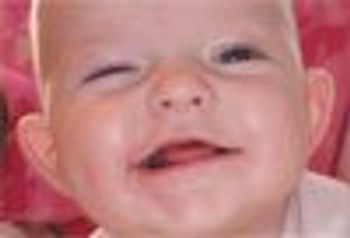
A 5-month-old girl presented with left facial droop of sudden onset. The infant had nasal congestion for the past 2 days, but had been eating well. There was no recent history of rash, trauma, medication use, or drug allergies.

A 5-month-old girl presented with left facial droop of sudden onset. The infant had nasal congestion for the past 2 days, but had been eating well. There was no recent history of rash, trauma, medication use, or drug allergies.

A 10-year-old boy had a 3-day history of an itchy eye. His mother thought he had somehow cut his upper left eyelid.

ABSTRACT: Adolescent drivers with attention deficit hyperactivity disorder (ADHD) are more likely to be involved in--and to die of--a driving accident than any other cause. The higher occurrence of driving mishaps is not surprising given that the core symptoms of ADHD are inattention, impulsivity, and hyperactivity. Safe driving habits can diminish the risk, however. The first step is to inform patients of the dangers of driving; the significance of adolescence, ADHD, and medication can be underscored in a written "agreement." Strategies to promote safer driving--especially optimally dosed long-acting stimulant medication taken 7 days a week--may be critical. A number of measures lead to safer driving by reducing potential distractions during driving (eg, setting the car radio before driving, no drinking or eating or cell phone use while driving, no teenage passengers in the car for the first 6 months of driving, and restricted night driving).

The rash on the upper torso, arms, and back of an 11-year-old started after he had a headache and fever for 3 days. The patient also has a distinctive pharyngitis with redness and some petechiae.

This full-term infant was born with malformed feet and toes. Physical examination findings were otherwise normal. The child weighed 3.1 kg (6.9 lb) at birth; her Apgar scores were 9 at 1 minute and 9 at 5 minutes. Her mother (21-year-old gravida 2 para 1) had an unremarkable antenatal history and a normal vaginal delivery. There was no family history of congenital anomalies.

A teenaged boy presented with this large, light brown pigmented macule that developed after he returned from a vacation with his family in Florida. He takes no medications and has been healthy.

Photoclinic: Sucking Blisters

How old does a child need to be before we can count on the accuracy of his or her response?

Sixteen-year-old boy referred to pediatric emergency department (ED) by his primary care physician with a history of headache, blurred vision, and mild proptosis of right eye. Vision: 20/200 OD (right eye) and 20/25 OS (left eye).

A 6-month-old white girl presented with a 2-day history of fever and respiratory symptoms. Initially, she was admitted with a diagnosis of respiratory syncytial virus bronchiolitis. In addition to her respiratory findings, widespread signs of rickets were found--ie, frontal bossing, rachitic rosary, widening of the wrists, and double maleoli.

During my training, most pediatric endocrinologists were using the "70/30 rule" or the "rule of fifths" to determine the insulin dosage for patients with new-onset diabetes. Now that I am in practice, I have heard that carbohydrate counting is a more accurate method of determining a child's insulin needs.

One of the most common illnesses we treat in general pediatrics is asthma-often in children who have not yet entered their teen years. While we ask the parents what symptoms they have noticed in their child, we don’t always ask younger children directly. How reliable are their answers?

Polycystic ovary syndrome (PCOS) isthe most common endocrinopathyamong reproductive-aged women; theprevalence is about 5% to 10%.